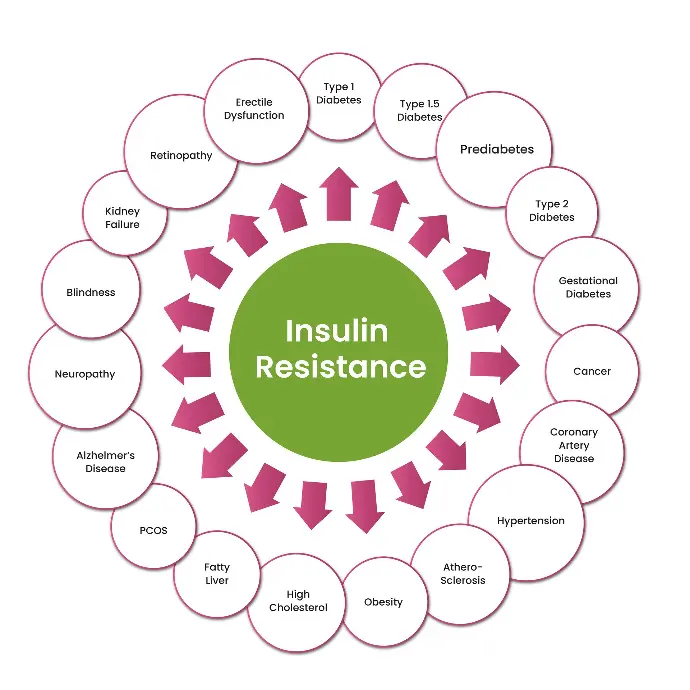Insulin resistance is the root cause of many chronic diseases. Often, being diagnosed with diabetes precedes the diagnosis of other chronic conditions, including coronary artery disease, metabolic syndrome, high cholesterol, hypertension, Alzheimer’s disease, cancer, stroke, and chronic inflammation.
When reversing insulin resistance using your diet, the goal is to become as insulin sensitive as possible, to prevent the development of these chronic diseases.
You don't need to go in for a ton of blood tests to measure your endogenous insulin and fret over some sort of 'fasting insulin levels chart'.

P Stands for Pressure (Blood Pressure)
Your blood pressure is a measurement of the effort it takes for your heart to circulate blood throughout your cardiovascular system. The higher your blood pressure, the harder your heart must work to push blood throughout your body.
In most cases, hypertension (high blood pressure) is caused by the hardening of blood vessels, which creates resistance against your heart. Over time, hypertension can become life-threatening, because it increases your risk for a heart attack or stroke
Most doctors prescribe medication to treat hypertension, unaware that simple dietary changes are more powerful and free of dangerous side effects.
The evidence-based research shows that hypertension is an independent risk factor for insulin resistance . Reducing your blood pressure to less than 120/80 (systolic/diastolic) without medication is essential in helping you reverse insulin resistance.
Recommended Blood Pressure Range
Systolic pressure = 100-120 mmHg
Diastolic pressure = 60-80 mmHg
I Stands for Ideal Body Weight
Being overweight elevates your risk for most chronic diseases, and is caused by the accumulation of fat in your adipose tissue as well as in tissues that are not designed to store fat, like your muscles and liver.
You can monitor your BMI to measure your progress at achieving your ideal bodyweight and reversing insulin resistance.
BMI:
18-24: Normal
25-30: Overweight
30 and above: Obese
L Stands for Lipids
When your lipid panel (total cholesterol, LDL, HDL, and triglycerides) is elevated, this often indicates an insulin resistant liver, or fatty liver. Fatty liver is usually diagnosed via imaging or elevated liver enzymes, resulting in an enlarged liver that is engorged with excess fat. As you gain insulin sensitivity, your cholesterol panel is likely to normalize.
In order to significantly reduce your risk for a heart attack, we recommend achieving the following fasting lipid panel:
Total Cholesterol: < 150 mg/dL
LDL Cholesterol: < 100 mg/dL
Triglycerides: < 150 mg/dL
HDL Cholesterol: > 50 mg/dL (for women)
HDL Cholesterol: > 40 mg/dL (for men)
A Stands for A1c
Hemoglobin A1c is often the first indicator that you are living with any form of diabetes. The evidence-based research indicates that the lower your A1c value, the better your blood glucose control, and the lower your risk for long-term complications.
The A1c guidelines set forth by the American Diabetes Association are as follows:
Type 2 Diabetes: > 6.4%
Prediabetes: 5.7–6.4%
Non-Diabetic: < 5.7%
F Stands for Fasting Blood Glucose
Your fasting blood glucose value is a key indicator of your level of insulin resistance, and is important to monitor daily when living with any form of diabetes. As you become more insulin sensitive, your fasting blood glucose is likely to decrease.
Monitoring your daily fasting blood glucose is a simple way to measure how your diet is affecting your glycemic control. The goal is to achieve a consistent fasting blood glucose between 80-100 mg/dL.
As you transition to a low-fat, plant-based, whole-food diet, you are likely to experience fluctuations in your fasting blood glucose, but an overall downward trend is a great indicator of increased insulin sensitivity.
Fasting Blood Glucose Target: 80-100 mg/dL
Refer to PILAF :
P: Pressure
I: Ideal bodyweight
L: Lipids
A: A1c
F: Fasting blood glucose
Please note: with each of these biomarkers, being free of oral medication to achieve these results is a key piece in understanding how insulin resistant you are. On the checklist, you’ll see “free of oral medication” as a checklist item, and one goal is to check that box for every biomarker.